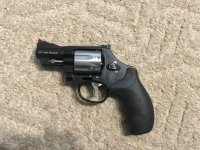Bill DeShivs
New member
Yes, as long as the end result is a fired primer.
But again, let's drive that nail- using a 2 lb. hammer works just fine and moves the nail X amount on each hit.
Now, try driving the same nail X amount using a tack hammer. You can't get enough speed on the tack hammer to do the job.
But again, let's drive that nail- using a 2 lb. hammer works just fine and moves the nail X amount on each hit.
Now, try driving the same nail X amount using a tack hammer. You can't get enough speed on the tack hammer to do the job.

